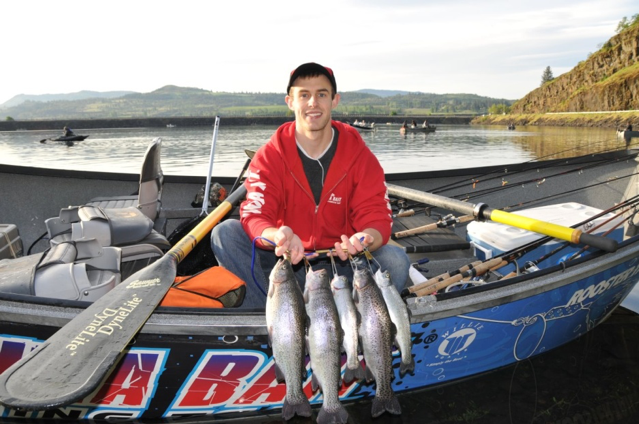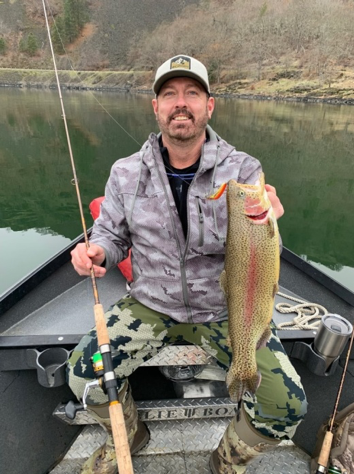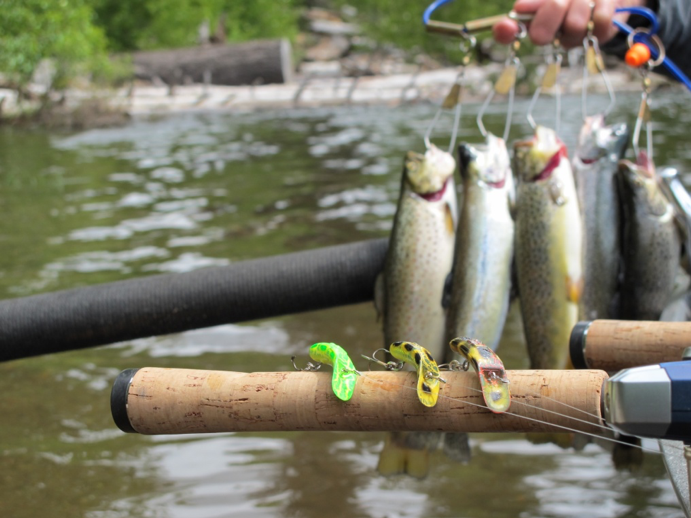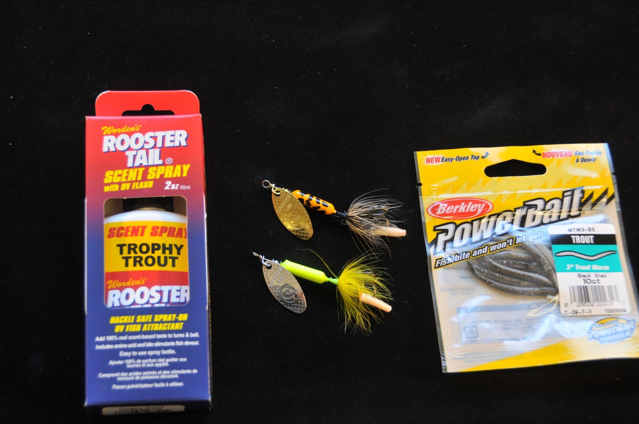Trolling for Trout
By: Buzz Ramsey
Rainbow and other trout (brown, brook and cutthroat) offer anglers fishing success in lakes and reservoirs where trolling is a popular way to catch them. Some water bodies host wild fish populations that sustain fisheries. But what populates most trout waters across America, from New York to Oregon, are millions of hatchery fish raised by State Fish & Wildlife and Federal agencies before release into local waters – all for you and me to catch.
Living in the Pacific Northwest, we spend much of our fishing time chasing salmon and steelhead, but pursue trout and other fish each-and-every year too. And while the trout planted in the lakes near our home are not always big, usually averaging 12-to-14 inches, we sometimes catch fish nearing the ten pound mark. These trout are fun to catch on light tackle and a challenge when bigger than expected.

Whether you move your boat along with a pair of oars or motor, what makes trolling affective is the amount of water you can cover, which pretty much guarantees the lures trailing behind your boat will come in contact with hungry fish.
The uses of oars or an electric trolling motor are popular means of propulsion when trolling because they facilitate slow going. For example, electric trolling motors are designed with a variable speed control that starts at zero. If your method of propulsion is a gas outboard, getting it to idle down may require a fresh tank of gasoline and, perhaps, a pre-adventure tune-up for it to run smoothly at low idle.
While trolling slowly is important, so is trolling in an erratic pattern. Fish that are initially attracted to your gear may lose interest if your offering doesn’t run away or swim erratically when approached. You can somewhat mimic a injured-prey reaction from predatory fish by zigzagging or changing your boat speed, which will often trigger following fish to striking before they lose interest.
The one lure that has changed our trolling success more than any other is a plug called Mag Lip. Mag Lip is distinctive due to its ability to dive extra-deep while yielding an erratic, darting “skip-beat” action that produces savage strikes from fish. The “skip-beat” action produced by Mag Lip adds tremendously to what we can achieve by changing boat speed and direction. The strike response due to the “skip-beat” action can be compared to how a house cat pounces when coaxed with a ball-and-string. Many guides and anglers report a higher hook-to-land ratio when using Mag Lip as compared to other lures and credit the savage strikes and better hook-to-land ratio to the unique action produced by this relative new to-the-market lure.

Determining the correct trolling speed depends on what lures you employ combined with the pace trout might respond to best. For example, you might troll a small FlatFish somewhere between a half and one (1) MPH, since this plug was designed to produce frantic action when pulled slowly. Trolling FlatFish at the speeds where they perform best can be especially effective when water temps are cool, fish are less aggressive, or when the forage they seek matches the size and color of this high-action plug. For spinner, spoon and plugs, like Mag Lip, the right trolling speed is usually in the range of 1 to 1-1/2 MPH, with 2 MPH considered fast on most waters.

When forward trolling, try positioning your lines at different distances behind your boat. Although the most productive distance might vary depending on water clarity and how boat shy fish might be, a good place to start is to run your lines from 50-to-100 feet out. Staggering the distance of each line means your gear will make multiple passes by the fish, increasing the chance of an encounter.
Another thing to keep in mind when trolling is the depth you position your gear. For example, trout might be found near the surface when the light is low, like early or late in the day and when overcast, but go deep when the sun is bright. Therefore, positioning your lines deeper during the middle of the day might keep the bite going. Water temperature can also affect where fish might be found as they will likely go deeper or suspend at a preferred temperature zone when surface temperatures get uncomfortable from summertime heat.
While Mag Lip dives deep the depth achieved varies based on line test (diameter), and distance out. For example, all according to Mark Romanack of Fishing 411 TV fame’s Precision Trolling Data App, the 2.5 (2-1/2 inch) size Mag Lip will dive eight feet with 50 feet of let out and ten feet with 75 feet of let out – this data is based on ten-pound test Berkley XT monofilament. You can add another foot of dive if using ten pound test Fireline, as this high-tech line is thinner than monofilament of the same test.
And while Mag Lip is our favorite plug for trout, we make use of other lures too. For example, there are times when a slow-trolling presentation produces best, which is when we employ the wild action produced by small FlatFish (sizes F-3 to F-7 for trout) at speeds ranging from a half to one mile-per-hour (MPH). Perhaps due to when trout are feeding on minnows, thin bladed spoons, like a Triple Teaser, sometimes produce best when trolled from 1-to-2 MPH.
The vibrating/fish-calling action of a spinner, like a Rooster Tail, works when forward trolled too. If you troll a spinner, keep in mind that their action can twist fishing line. Therefore, it’s important to rig a ball-bearing or other quality swivel twenty or so inches from your spinner or halfway down your leader when rigged in combination with a sinker, attractor or downrigger.
Adding a fish attractant to any lure can increase its effectiveness. You’ll find an innumerable array of scents available for this purpose. In addition to spraying my lures with an attractant, like Rooster Tail Scent Spray, I often add a short section (usually a half inch or so) from a scent-filled worm, grub or maggot (PowerBait or Gulp!) to the hook of my plug, spinner or spoon – just rig it to hang straight back.

If you tip spoons, be advised that employing too large a tip can deaden their action – so keep tipping baits extra short on spoons. Although the above tipping baits are available in different colors, we’ve found the white or black colors often produce best, at least on the trout lakes near our home.
